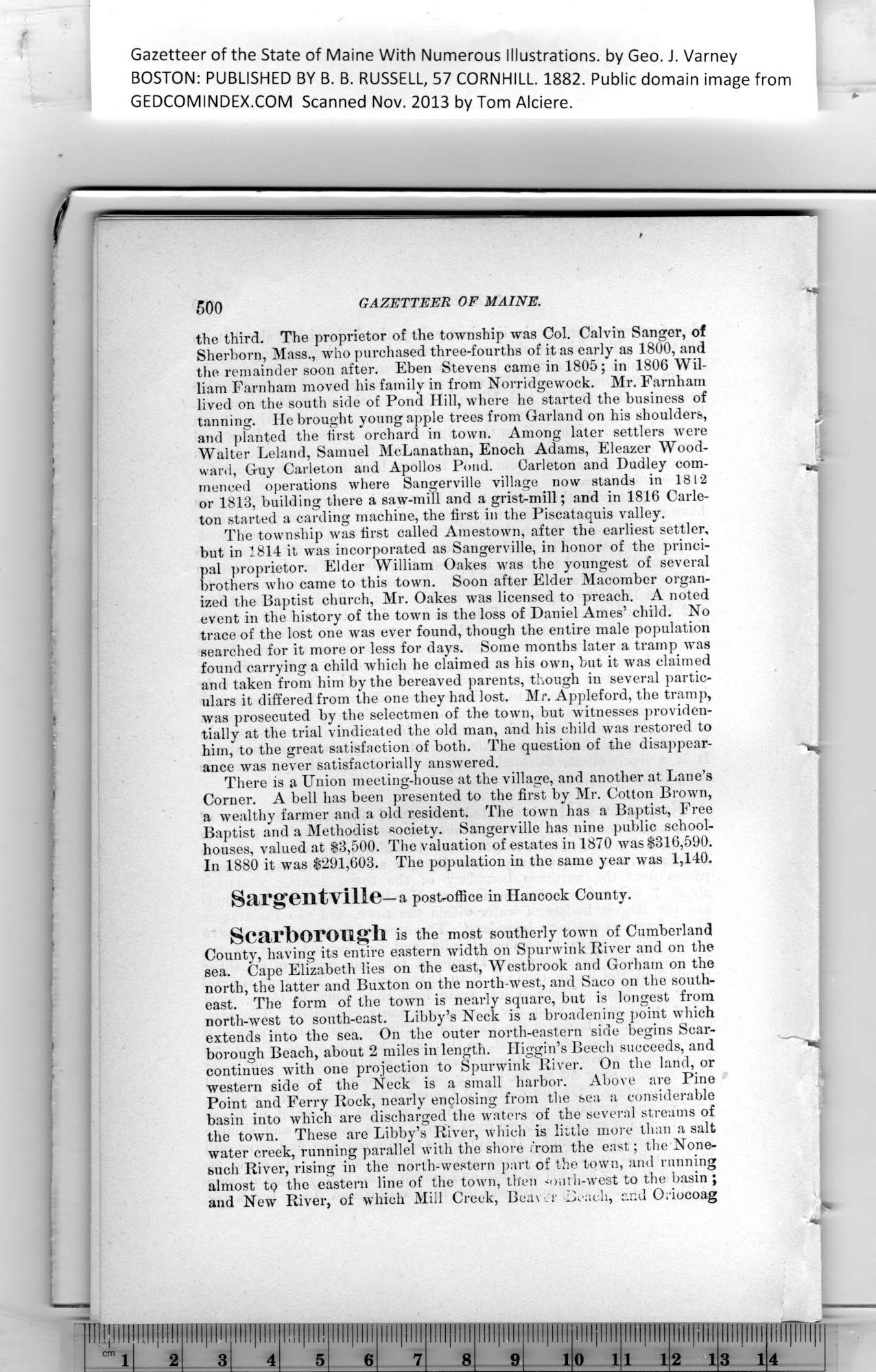|
Gazetteer of the State of Maine With Numerous Illustrations, by Geo. J. Varney
BOSTON. PUBLISHED BY B. B. RUSSELL, 57 CORNHILL. 1882. Public domain image from
500 GAZETTEER OF MAINE.
the third. The proprietor of the township was Col. Calvin Sanger, of
Sherborn, Mass., who purchased three-fourths of it as early as 1800, and
the remainder soon after. Eben Stevens came in 1805; in 1806 Wil-
liam Farnham moved his family in from Norridgewock. Mr. Farnham
lived on the south side of Pond Hill, where he started the business of
tanning. He brought young apple trees from Garland on his shoulders, 'Jjt
and planted the first orchard in town. Among later settlers were
Walter Leland, Samuel McLanathan, Enoch Adams, Eleazer Wood-
ward, Guy Carleton and Apollos Pond. Carleton and Dudley com-
menced operations where Sangerville village now stands in 1812
or 1813, building there a saw-mill and a grist-mill; and in 1816 Carle-
ton started a carding machine, the first in the Piscataquis valley.
The township was first called Amestown, after the earliest settler,
but in 1814 it was incorporated as Sangerville, in honor of the princi-
pal proprietor. Elder William Oakes was the youngest of several
brothers who came to this town. Soon after Elder Macomber organ-
ized the Baptist church, Mr. Oakes was licensed to preach. A noted
event in the history of the town is the loss of Daniel Ames’ child. No
trace of the lost one was ever found, though the entire male population
searched for it more or less for days. Some months later a tramp was
found carrying a child which he claimed as his own, hut it was claimed
and taken from him by the bereaved parents, though in several partic-
ulars it differed from the one they had lost. Mr. Appleford, the tramp,
was prosecuted by the selectmen of the town, but witnesses providen-
tially at the trial vindicated the old man, and his child was restored to
him, to the great satisfaction of both. The question of the disappear-
ance was never satisfactorially answered.
There is a Union meeting-house at the village, and another at Lane’s
Corner. A bell has been presented to the first by Mr. Cotton Brown,
a wealthy farmer and a old resident. The town has a Baptist, Free
Baptist and a Methodist society. Sangerville has nine public school-
houses, valued at $3,500. The valuation of estates in 1870 was $316,590.
In 1880 it was $291,603. The population in the same year was 1,140.
Sarg, Ollt VillC—a post-office in Hancock County.
Scarborough is the most southerly town of Cumberland
County, having its entire eastern width on Spurwink River and on the
sea. Cape Elizabeth lies on the east, Westbrook and Gorham on the
north, the latter and Buxton on the north-west, and Saco on the south-
east. The form of the town is nearly square, but is longest from
north-west to south-east. Libby’s Neck is a broadening point which
extends into the sea. On the outer north-eastern side begins Scar-
borough Beach, about 2 miles in length. Higgin’s Beech succeeds, and
continues with one projection to Spurwink River. On the land, or
western side of the Neck is a small harbor. Above are Pine
Point and Ferry Rock, nearly enclosing from the sea a considerable
basin into which are discharged the waters of the several streams of
the town. These are Libby’s River, which is little more than a salt
water creek, running parallel with the shore from the east; the None-
such River, rising in the north-western part of the town, and running
almost tQ the eastern line of the town, then <outh-west to the basin ;
and New River, of which Mill Creek, Boavu- Beach, and Oriocoag
PREVIOUS PAGE ... NEXT PAGE
This page was written in HTML using a program written in Python 3.2
|
